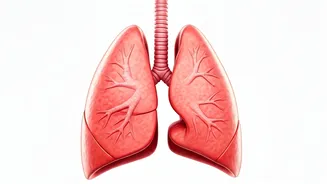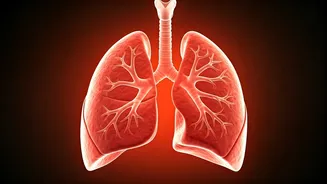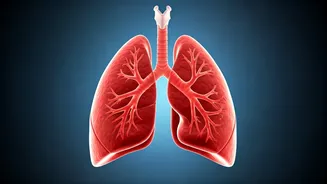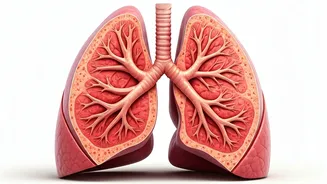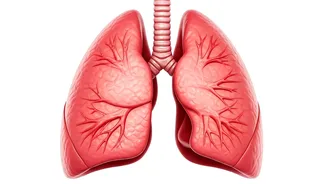Diaphragmatic Breathing
Diaphragmatic breathing, often referred to as belly breathing, stands out as a foundational exercise for enhancing lung function. The process involves
engaging the diaphragm, a significant muscle in the respiratory system, to facilitate deeper breaths. To practice this, lie down comfortably or sit upright, placing one hand on your chest and the other on your abdomen. As you inhale slowly through your nose, focus on allowing your abdomen to rise, ensuring your chest remains relatively still. Exhale slowly through your mouth, feeling your abdomen gently fall. This technique maximizes oxygen intake and promotes efficient gas exchange within the lungs. This practice improves lung capacity and strengthens the respiratory muscles over time. Performing this exercise for 5-10 minutes daily can significantly improve respiratory health and reduce stress levels. Incorporating diaphragmatic breathing into your daily routine is a simple, yet highly beneficial way to enhance your respiratory well-being.
Pursed-Lip Breathing
Pursed-lip breathing is a straightforward technique particularly helpful for individuals experiencing shortness of breath or those with chronic lung conditions. This method aids in slowing down your breathing rate and keeping your airways open for a longer duration, enabling more efficient oxygen intake and carbon dioxide expulsion. To perform pursed-lip breathing, start by inhaling slowly and deeply through your nose. Then, purse your lips as if you're about to whistle. Exhale slowly through your pursed lips, taking twice as long as your inhalation. This technique creates back pressure in your airways, preventing them from collapsing and trapping air. Practicing pursed-lip breathing can alleviate breathlessness, reduce anxiety, and improve overall lung function. It is particularly valuable during physical activity or periods of stress. This technique provides immediate relief from breathlessness. Consistent practice can lead to a marked enhancement in respiratory efficiency and comfort.
Deep Breathing Exercises
Deep breathing exercises involve consciously expanding the lungs to their full capacity, promoting better oxygenation and lung function. These exercises encompass a variety of techniques designed to encourage deep, controlled breaths. A simple deep breathing exercise involves inhaling deeply through the nose, holding your breath for a few seconds, and exhaling slowly through your mouth. Another variation includes inhaling deeply, holding your breath, and exhaling in a series of short bursts. Regular practice of deep breathing exercises can increase lung capacity, improve oxygen levels in the blood, and promote a sense of relaxation. Deep breathing enhances the exchange of oxygen and carbon dioxide, which supports overall respiratory health. These exercises can be performed at any time and in any location, making them an accessible way to support your respiratory health during winter and year-round.
Cardiovascular Exercises
Cardiovascular exercises, encompassing activities such as brisk walking, jogging, swimming, or cycling, play a crucial role in strengthening the lungs and improving overall respiratory function. These activities raise your heart rate, which in turn increases the demand for oxygen, pushing your lungs to work harder and more efficiently. When you engage in cardio, your body becomes more adept at utilizing oxygen and removing carbon dioxide. Regular cardio workouts boost lung capacity and improve the efficiency of gas exchange within the lungs. A consistent cardio routine enhances cardiovascular health and fortifies your respiratory system. Aim for at least 150 minutes of moderate-intensity cardio, such as brisk walking, or 75 minutes of vigorous-intensity cardio, such as jogging, each week. Incorporating cardiovascular exercises into your weekly schedule is essential for maintaining optimal lung health and enhancing overall well-being.
Posture Exercises
Good posture significantly affects lung function, as it allows your lungs to expand fully, thereby enhancing oxygen intake. Exercises focusing on posture improvement can significantly bolster respiratory health. Simple posture-enhancing exercises include shoulder blade squeezes, chin tucks, and chest stretches. To practice shoulder blade squeezes, sit or stand with your back straight, squeeze your shoulder blades together, and hold for a few seconds before relaxing. For chin tucks, gently pull your chin towards your neck while keeping your eyes forward. Chest stretches can be done by clasping your hands behind your back and gently pulling them away from your body. These exercises counteract the effects of poor posture, which can compress the lungs and restrict breathing. Improving your posture allows for optimal lung expansion. Regularly performing posture exercises can significantly enhance respiratory function and promote better overall health. These simple adjustments can make a considerable difference in your breathing and general well-being.
